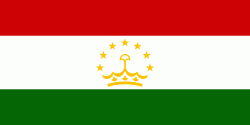Roshtqal'a District (Roshtqal'a District)
Roshtqal'a District or Nohiya-i Roshtqal'a (Рошткалинский район, Ноҳияи Роштқалъа, also spelled Roshtkala from Russian transliteration) is a district in eastern Tajikistan, in the south-western part of the Gorno-Badakhshan Autonomous Region (GBAO). It stretches along the river Shakhdara between the Shughnon Range to the north and the Shakhdara Range to the south, enclosed within GBAO, without international borders. The population of Roshtqal'a district is 27,400 (January 2020 estim.). Its administrative capital is the village Roshtqal'a in the west part of the district, about 30 km south-east of the regional capital Khorugh.
The district coincides with the valley of the river Shakhdara. It is bounded on the north by Shughnon District, on the west and south by Ishkoshim District and on the east by Murghob District. Unlike the neighboring districts, it does not go all the way west to the river Panj.
Roshtqal'a town, the district capital, is about 30 km upstream from Khorog. The name means 'red fort'. The fort, built in the 9th-10th century (ruins only) was once the capital of Shugnan.
The river Shakhdara defines the district. Its valley is between the Shugnon Range in the north and the Shakhdara Range in the south. It flows into the Gunt above Khorog a few miles before that river flows into the Panj. Going upstream, it first goes southeast for about 40 km(straight line). At Bidiz there is a gorge and one of the few forests in Gorno-Badakhshan. The river turns east. At Sindev is the fort of the last Mingbashi or ruler of Shakhdara. The head of the river is the Jawshangoz plain where there were clashes between nomadic Kirghiz and settled Tajiks in the 18th and 19th centuries. There is a ruined fort from the 2nd or 3rd century and views of Karl Marx Peak to the south. A road of some sort goes north to the Koitezek Pass on the Pamir Highway with a branch west to Turumtaikul Lake and another route goes over the Maz pass to the Pamir River.
The district has an area of about 4300 km2 and is divided administratively into six jamoats. They are as follows:
The district coincides with the valley of the river Shakhdara. It is bounded on the north by Shughnon District, on the west and south by Ishkoshim District and on the east by Murghob District. Unlike the neighboring districts, it does not go all the way west to the river Panj.
Roshtqal'a town, the district capital, is about 30 km upstream from Khorog. The name means 'red fort'. The fort, built in the 9th-10th century (ruins only) was once the capital of Shugnan.
The river Shakhdara defines the district. Its valley is between the Shugnon Range in the north and the Shakhdara Range in the south. It flows into the Gunt above Khorog a few miles before that river flows into the Panj. Going upstream, it first goes southeast for about 40 km(straight line). At Bidiz there is a gorge and one of the few forests in Gorno-Badakhshan. The river turns east. At Sindev is the fort of the last Mingbashi or ruler of Shakhdara. The head of the river is the Jawshangoz plain where there were clashes between nomadic Kirghiz and settled Tajiks in the 18th and 19th centuries. There is a ruined fort from the 2nd or 3rd century and views of Karl Marx Peak to the south. A road of some sort goes north to the Koitezek Pass on the Pamir Highway with a branch west to Turumtaikul Lake and another route goes over the Maz pass to the Pamir River.
The district has an area of about 4300 km2 and is divided administratively into six jamoats. They are as follows:
Map - Roshtqal'a District (Roshtqal'a District)
Map
Country - Tajikistan
 |
 |
| Flag of Tajikistan | |
The territory that now constitutes Tajikistan was previously home to several ancient cultures, including the city of Sarazm of the Neolithic and the Bronze Age and was later home to kingdoms ruled by people of different faiths and cultures, including the Oxus civilization, Andronovo culture, Buddhism, Nestorian Christianity, Hinduism, Zoroastrianism, Manichaeism, and Islam. The area has been ruled by numerous empires and dynasties, including the Achaemenid Empire, Sasanian Empire, Hephthalite Empire, Samanid Empire, and Mongol Empire. After being ruled by the Timurid Empire and Khanate of Bukhara, the Timurid Renaissance flourished. The region was later conquered by the Russian Empire and subsequently by the Soviet Union. Within the Soviet Union, the country's modern borders were drawn when it was part of Uzbekistan as an autonomous republic before becoming a full-fledged Soviet republic in 1929.
Currency / Language
| ISO | Currency | Symbol | Significant figures |
|---|---|---|---|
| TJS | Tajikistani somoni | ЅМ | 2 |
| ISO | Language |
|---|---|
| RU | Russian language |
| TG | Tajik language |















